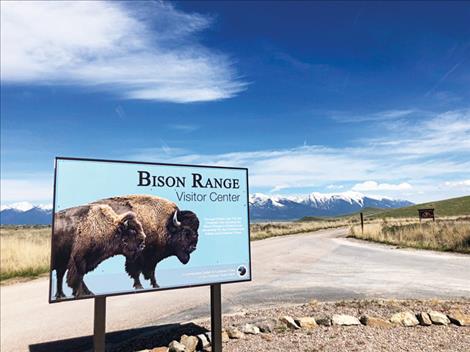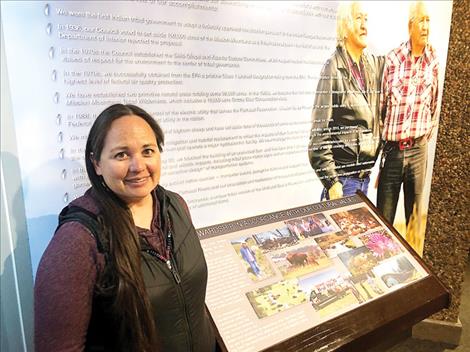Bison Range celebrates reclamation
Hey savvy news reader! Thanks for choosing local.
You are now reading
1 of 3 free articles.
MOIESE — At the Bison Range near Moiese, life goes on much as it has for millennia, with sunny clumps of arrowleaf balsamroot carpeting hillsides and babies of all species taking their first staggering steps. For members of the Confederated Salish and Tribes, however, a monumental shift has taken place, with the Tribes regaining ownership of the 18,800-acre wildlife refuge from the federal government. Nowhere is that change more apparent than at the Visitors’ Center.
Stephanie Gillin, information and education program manager for the Natural Resource Department, has taken the lead in revamping the interpretive area to accurately reflect the history of the range and the people who called this place home well before Lewis & Clark arrived.
Her vision, and that of tribal elders, was unveiled Mother’s Day weekend when Red Sleep Drive officially opened for the season and will be on full display from May 20 to 22 during a three-day “Bison Range Restoration Celebration,” honoring the long-sought transfer of the range from federal to tribal stewardship.
“This monumental day has been a long time coming,” said CSKT Tribal Chairman Tom McDonald. “This day not only represents the righting of a terrible time in our U.S. history, but also represents much needed healing for our people and our ancestors.”
The change from federal to tribal ownership was authorized by the Montana Water Rights Protection Act, signed into law Dec. 27, 2020. The Tribes assumed full management on Jan. 2, after working closely with the U.S. Fish and Wildlife Service for over a year to ensure a smooth transition.
The Restoration Celebration kicks off Friday, May 20, with Tribal Member and Community Day at the Bison Range. Festivities open at 10 a.m. with a prayer and honor song delivered by the Honor Guard and Veterans Warrior Society. A community lunch will be served between 11:30 a.m. and 12:30 p.m. in the picnic area. The celebration powwow runs from 12-4 p.m., and native games are also on tap. The first 100 dancers in regalia will receive $25 gift cards.
On Saturday, May 21, the Tribes host a Community Celebration at Salish Kootenai College in Pablo, beginning at 2 p.m. with a screening of the 30-minute documentary, “In the Spirit of Atatice,” at the Johnny Arlee and Vic Charlo Theatre. The film, which shows again at 3 p.m., tells the remarkable story of how two Pend d’Oreille men, father and son, saved a small herd of orphaned bison calves – remnants of the vast herds that were hunted nearly to extinction in the 1800s – and how those animals eventually formed the backbone of the Bison Range herd.
A community meal will be served at 2:30 p.m. and the afternoon’s events culminate with the Community Celebration at 4 p.m. in the Joe McDonald Health Fitness Center gym. On Sunday, gate fees at the Bison Range are half price for Community Appreciation Day. Admission is always free for tribal members.
To commemorate the transfer, the Tribes will be giving away a limited number of t-shirts, stickers, posters, and water bottles at both the Friday and Saturday celebrations.
“We are excited to share this event with our community and all of those people who helped make it possible,” says McDonald.
For Gillin, overseeing the transformation of the Bison Range Visitors’ Center to accurately reflect the tribal story has been both personal and professional. Since last April, she’s worked closely with science writer, researcher, and longtime tribal consultant David Rockwell to stitch together, panel by panel, displays that trace tribal history and culture, and explain the significance of the refuge and the herd of bison that lives there. Tribal elders from both the Salish and Kootenai Culture Committees were consulted every step of the way.
“I didn’t want to just throw things on the wall,” says Gillin. “I wanted it to be represented the right way.”
She also kept in mind the spirit of her grandmother, Felicity McDonald – a tribal elder whose first language was Salish, and who helped establish the culture committee in the 1970s and translated interviews with native speakers from Salish to English until she was nearly 90.
“She was here for us, to instill this, so we had the knowledge to know who we are, and to pass that on to our kids,” Gillin says, pointing to a photograph of her ya-ya.
“So full circle, here I am, passing it on, making it better for future generations,” she adds. “That’s our job as Native people, to keep passing on that connection.”
Each exhibit thoughtfully articulates a history and culture seldom learned in public schools, from the large portraits of the three chiefs – Alexander, Charlo and Koostatah – that greet visitors, to displays that show the vast aboriginal territories tribal people once inhabited, circumscribed by the Hellgate Treaty of 1855, and show how railroads brought hunters and near extinction to the bison many aboriginal people depended upon.
“The bison remind me of Native people and our struggles. But like them, we’re still here,” says Gillin. “We relied on them for so many things. In turn, our story of helping preserve their numbers only strengthens the story of us depending on one another, getting through, and still surviving.”
The museum at the Visitors’ Center, “is first and foremost for our people to hear and know our story the right way and for the community and our visitors to understand us as Native people, to understand our story, our connection to these animals, the land and the water,” she adds.
Threaded throughout the museum are two themes: the Tribes’ history of conservation and the cultural significance of places, plants and animals, since “culture is mixed in with everything we do.”
One panel focuses on Big Medicine, the sacred albino buffalo born at the Bison Range in 1933, whose body is now on display at the Montana Historical Society in Helena. Gillin says the Tribes are negotiating for the eventual return of Big Medicine to his birthplace. “We have a space saved for him, just in case it happens.”
In another nod to history, the Tribal Council recently voted to name the Visitors’ Center for the late Tribal Chairman Mickey Pablo, “because of his forward thinking and initial charge to get the Bison Range back.”
Also of note:
• The former theater has been transformed into a gift shop that offers art and crafts by tribal members and Montana artists, books for all ages, clothing, Pendleton blankets, children’s games and stuffed animals – most with a focus on local wildlife.
• The Bison Range employs around a dozen workers, from a maintenance crew to Visitors’ Center employees to security staff. The range will also serve as headquarters for tribal game wardens, who are currently stationed in Polson.
• The 19-mile Red Sleep Drive is now open for the summer season, while the Buffalo Prairie Drive, a 14-mile round trip, is open year around. Vehicles over 30 feet long or those towing trailers, motorcycles and bicycles are not permitted on either route.
• The Visitors’ Center and Gift Shop hours are 7 a.m.-7 p.m. and the entrance gate on Hwy. 212 is open from 7 a.m.-8 p.m. For non-tribal members, admission is $10 a day or $20 for a season’s pass, and Tribal Recreation Permits are not required, except for fishing access.
For more information, visit www.facebook.com/CSKTBisonRange or bisonrange.org.

















